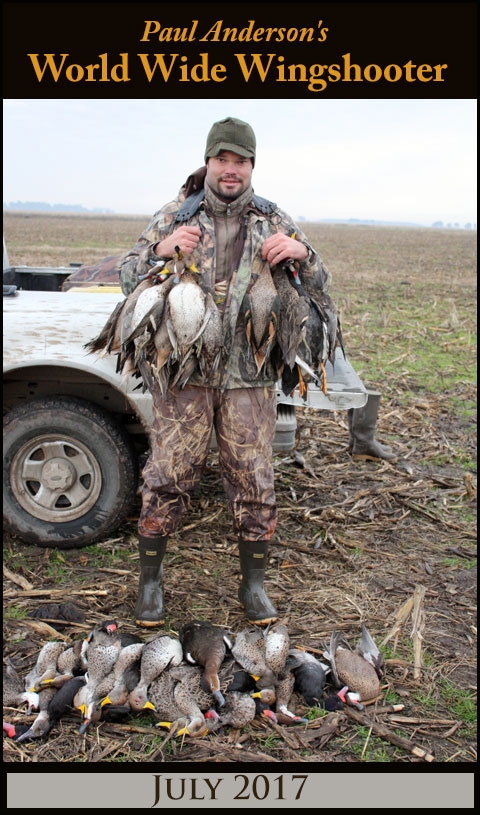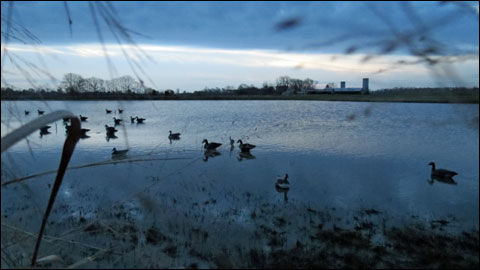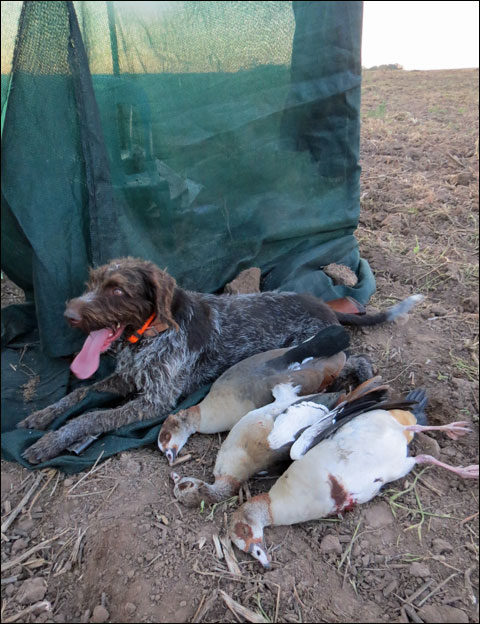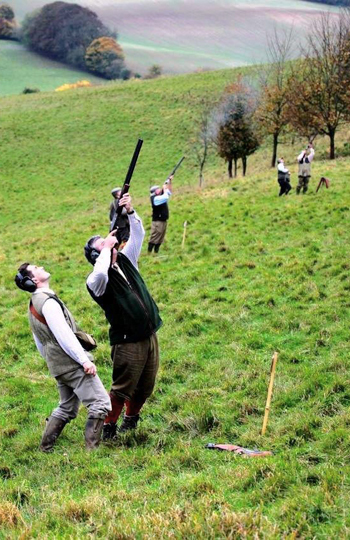My Wingshooting Bucket List

In my early years of bird hunting I started a bucket list by pouring over the magazines by my father’s Lazy Boy. I would memorize item numbers in Lyon Country Supply, and dream of the day I had my own real bird dog. Dreams of skidding points, and huge Canadian geese in the decoys, banded green heads and woodcock over a Llewellyn or any other bird hunt I could read about and absorb.
In those early years my bucket list was simple and far to narrow. It mostly consisted of things I saw my father and uncles do. Goose hunts, shoot quail, own a fine bird dog − simple things for a simple time of life.
As I’ve gotten older and more experienced I have developed a more challenging bucket list − a list that is both doable yet challenging. A bucket list that any international wingshooter can be proud of. You might say, “Well if he’s writing a column about international wingshooting, shouldn’t he have done these already?” To that I say, “You’re probably right.” There is a lot for me still to do and I look forward to sharing my adventures as I complete this list. This is an evolving list, and has many goals, but let’s just go with the top ten on my bucket list of bird hunts.
Number 1 – The King Eider
Found in northern Coastal Arctic areas, the King Eider is one tough duck. It’s hunted in the depths of winter in some of the coldest areas of North America. To hunt Kings makes a late December hunt in Arkansas look like a spring picnic. Eider are hunted from small islands in the middle of the ocean. Sometimes many many miles from shore, small rocky islands that destroy equipment as the wind blows saltwater into everything. Many consider a King Eider hunt the most extreme duck hunt in the world, and I’d have to agree with them. When one combines the difficulty of the hunt, travel and weather with the beauty of a King Eider Drake this stands easily at the top of my bucket list.
Number 2 – Driven Red-Legged Partridge in Spain
There’s something about the pomp and circumstance that surrounds a well-run driven shoot. The tweeds, centuries of heritage and traditions come together to form an amazing experience. Driven shoots are not cheap, and the accommodations normally reflect that. The shoot I would go on is run out of a castle near the historic town of Toledo. With game parades and breathtaking food and wines always available. This is a trip for both the volume shooter as well as the more refined, dinner dress and tweeds. A far cry from blaze orange and blocking off a corn field in South Dakota.

Ventosilla Castle in Spain is a top destination for driven Red-Legged Partridge.
Number 3 – Chesapeake Bay Waterfowl
Here is where history calls to me from the stories read as a boy of punt guns and birds to black out the sky. While Chesapeake Bay may not be what it once was, sitting in a modern lay out boat with modern decoys in the middle of this historic bay is very high on my list! And the whole time I’m there, I’ll think of the market hunters, the thousands of men who came before, and the millions upon millions of ducks that have passed through the nation’s largest estuary for a millennia.

A goose decoy spread on Maryland’s Eastern Shore.
Number 4 – South African Birds
It’s no surprise that the bird hunting opportunities in Africa are as varied as the big game. The main reason I have put South Africa so high on this list is because of three birds. First the mighty Spur Wing Goose, the supposed largest goose in the world. It’s a quiet species and you have to be on the “X” if you’re wanting a good shoot. Secondly, the Egyptian Goose, found in good numbers and is a great looking bird. Having grown up hunting Swan Lake National Wildlife Refuge in Sumner, Missouri I have had a lifelong love of big geese. Lastly, the South African bird I’m looking most forward to shooting is the Grey-Winged Partridge, a bird that coveys and holds well to dogs. A couple days of following a brace of English Pointers in the highlands of South Africa is a dream come true.

Egyptian Geese taken on a wingshooting expedition to South Africa.
Number 5 – Michigan’s Upper Peninsula, Woodcock and Grouse.
History here is also important, but in all honesty it’s the bird numbers and the ecosystem they live in. Having grown up reading of setters and pointers holding a woodcock in deep cover, with the streams and trout, in all of North America few places capture my imagination like the Upper Peninsula − not to mention how truly remote you can get there.
Number 6 – North American Sandhill Cranes
While I have hunted them several times, I have never shot at one. From Canada to Kansas I have tried and tried to score on a Sandhill Crane, with no success. This year though is the year! I’ll be hunting the panhandle of Texas several times this year with TxFowl and am looking forward to seeing how it’s done! Considering he scouts with a plane I’m sure we should get on the birds. The main reason for my crane obsession? I have to know if they are really the Filet Mignon of the Sky.

Cranes harvested in a Texas hunt.
Number 7 – Eurasian Western Capercaillie
Found throughout Eurasia, the Capercaillie is the world’s largest grouse. It’s hunted in several different ways, from dogs to calling. A very large black bird with tons of personality, found in the deep forest of Eastern Europe, the habitat in which you find these birds seems straight out of a fairy tale. The idea of hunting the storied forests of Eastern Europe and Western Asia is something that has always been on my radar. One of my favorite recurring dreams is a big black bird flushing through a dark primeval forest.
Number 8 – Oscillated Turkey, Yucatan Peninsula
Nothing like the turkeys we know up north, this is a subspecies that few turkey hunters ever even consider. The keystone of National Wild Turkey Foundation’s World Slam, the Oscillated Turkey is a beautiful bird that rivals a peacock in colors and beauty. They are either called, or hunted over bait, deep in the jungles of the Yucatan. Not only is this a trophy bird, but the area in which it is hunted is rich in culture, and heritage.
Number 9 – Geese in Scotland
Who doesn’t want to go to Scotland? The distilleries alone could hold my attention, but really it’s the way in which Scots hunt. With a certain flair and tradition, both things I’ve grown to appreciate. The specific trip I’d like to take is to the Orkney Islands just off the Scottish coast, for Pinkfoot and Greylag geese. This is a less tourist-traveled area of Scotland and a place I think would feel like any rural area of North America. The hunting is done over decoys and seems to me to be very similar to the spreads and layout blinds we use here in the states.
Number 10 – Driven Birds in the U.K.
Talk about some options! Shooting driven birds in England is something that I’ve always wanted to do. The heritage of U.K. shooting is the main attraction, the traditions that go with the shoot, and the game parades. The formality of it all, combined with respect for the game and land is something that I feel I must learn. If I could have my choice, I would spend several months under the tutelage of one of several well-known gamekeepers. I know how we do it, how do they?

A driven hunt in the U.K.
Wrap-Up
It’s my hope that you’ve enjoyed this short list, and maybe it will help fuel a fire in you as well. I know I’ve spent more time day dreaming while writing this than I should. Also, I hope you enjoy following along as I try to achieve these goals. At 37 years of age, I have time and am looking forward to a future filled with feathers and the smell of spent shells.
If one of these trips piques your interest and you’re looking for someone to go with, please give me a call.
Paul Anderson is Vice President of Detail Company Adventures at http://detailcompany.com. Based in Houston, Texas, Detail Company Adventures has been offering high-quality wingshooting, fishing and big game hunts in South America, Europe and America for more than 25 years. If you have any questions or need some advice feel free to contact Paul at paul@detailcompany.com or (800)292-2213.

If you have any questions or need some advice, please contact me at paul@detailcompany.com or (800)292-2213.


Comments